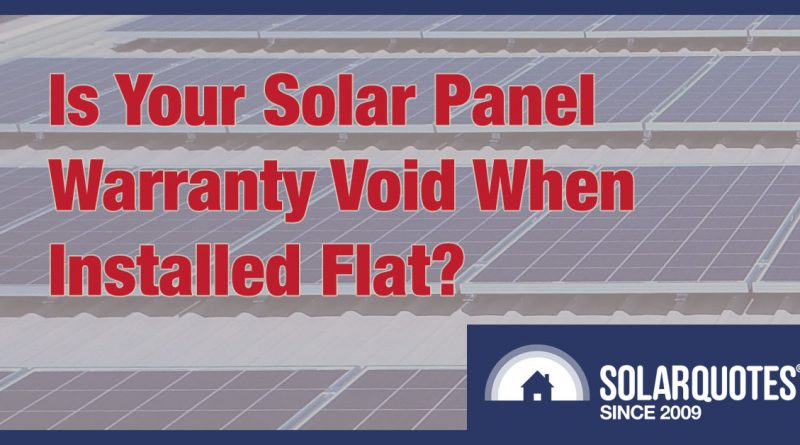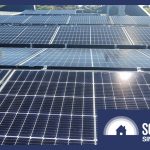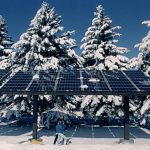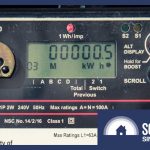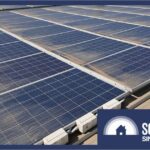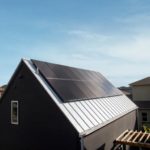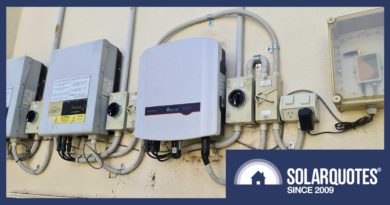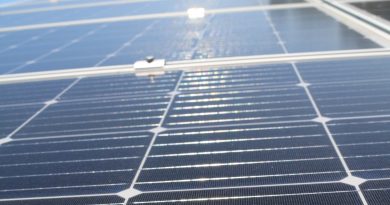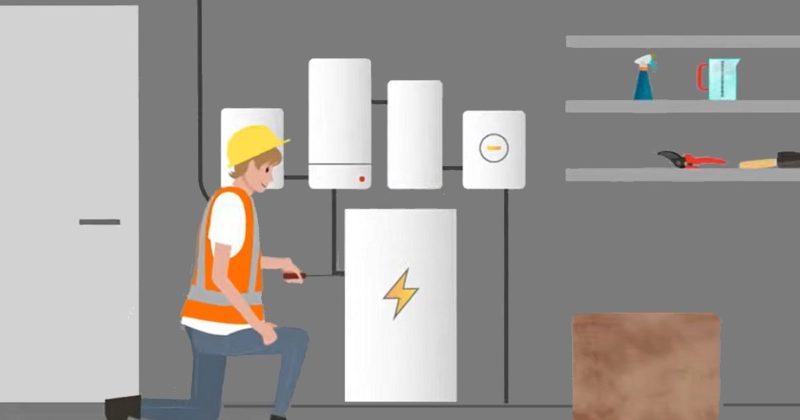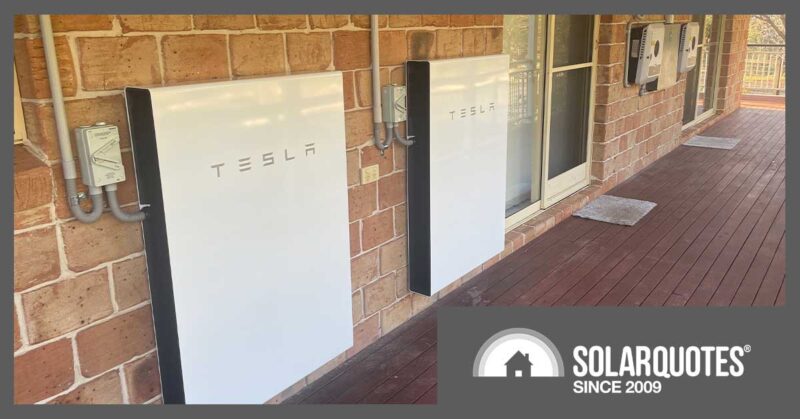Which Solar Panels Can Be Installed Flat Without Voiding Their Warranty?
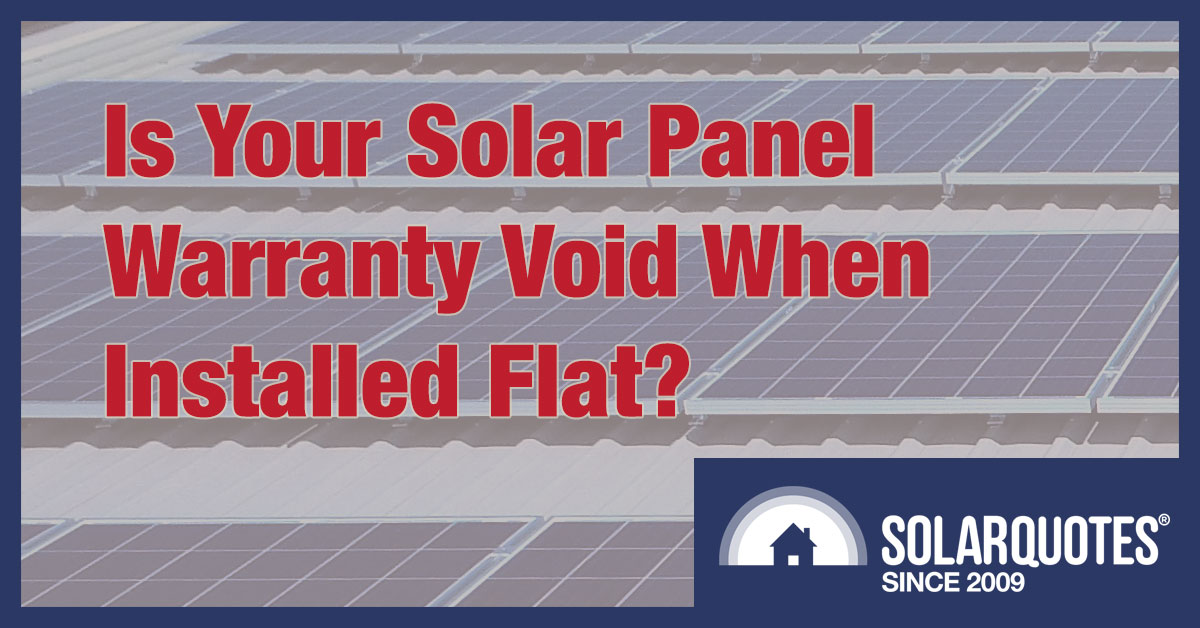

Solar panel warranties have lots of interesting conditions in them. Some require panel cleaning while others forbid any shading of any panels.
I’ve even found one that says it’s rendered void by damage from “lighting“, which is something you’d hope a solar panel could handle.
For this blog post, I’m considering just one condition — whether or not solar panels can be installed flat.
By flat, I don’t mean installed flat against a roof that’s sloped. I mean flat, so the panel itself has a tilt of zero degrees or close to it.
Out of the 19 brands we have on our recommended solar panels chart, I found the following…
- One manufacturer — SunPower — clearly states you can install their panels at any angle.
- 13 don’t forbid their panels from being installed flat, although they usually recommend installation at an angle.
- 5 brands forbid their solar panels to be installed flat, but Q CELLS can be installed at a minimum angle of 3º from horizontal.
What’s Wrong With Flat Panels?
My advice is to never install solar panels flat unless…
- Your only other option would be to install a smaller solar system or no solar at all, and…
- You don’t mind dealing with the potentially dirty consequences.
Tip: A great solution for many flat roofs is to use a savvy installer and special East-West tilt frames that Finn describes here.
Panels with a tilt of 10º or more usually don’t need cleaning because they’re steep enough for rain to run off them and carry away dirt. But less than this can cause water plus dirt to pool up at the edge of the frame — or in the centre of the solar panel if it’s installed completely flat. When it evaporates, it can leave behind firmly stuck grime that can build up over time.
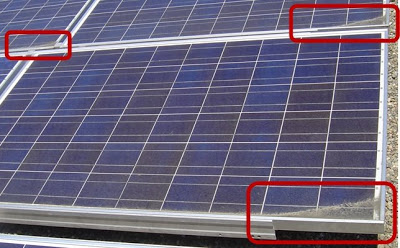
Evaporating water has left baked on grime in the corners of these nearly flat panels. (Image: Google — as in Google installed them and took this photo. I didn’t just Google up a random image.)
You must clean off this dirt build-up regularly to maintain energy output. Once a year may be enough, but they may require more frequent cleaning if they’re completely flat or in an especially dirty location.
Some types of solar panels may have an advantage at resisting dirt when installed at a low angle:
- Frameless panels make it easy for water to flow off them since they have no frame to pool against, but often have a major drawback in requiring annual inspections to ensure the clamp tension is suitable. Because the clamps are touching glass, it has to be just right.1
- Some solar panels have been made with channels in the corners to allow water to flow away easily, but they can be hard to find these days.
- There are manufacturers claiming their panels have coatings that allow them to stay cleaner than others. I don’t have any information on how well these work long term.
Home Roofs Rarely Fully Flat
The two most common roof tilts are 15º and 22.5º. So if the slope of your roof looks pretty average, solar panels should have enough tilt for rain alone to keep them clean in most locations. But residential roofs that look flat usually have a slight slope. It may only be a few degrees to prevent water pooling on the roof surface, but just a few degrees can make all the difference in how dirty panels get.
Manufacturers may say their panels can’t be installed flat but not give the minimum tilt, so you may need to contact them if you want to install some solar panels on a nearly flat roof.
Regardless Of Warranty, You’re Protected By Australian Consumer Guarantees
Unfortunately, it’s not uncommon for solar panel warranties to contain conditions that make them worthless if the manufacturer doesn’t feel like treating customers fairly. Fortunately, you’re protected by Australian Consumer Guarantees. These apply regardless of what a warranty says. This doesn’t mean it’s okay to install a panel flat if the installation manual says not to, but you are protected from manufacturers evading their responsibility to provide reliable panels based on warranty fine print.
Warranties for use in Australia are supposed to contain a passage giving information on Australian Consumer Law. Here’s an example from an LG Solar warranty:


19 Solar Panel Brands Checked
I checked the warranties for 19 different panel brands – all the ones on our recommended chart:
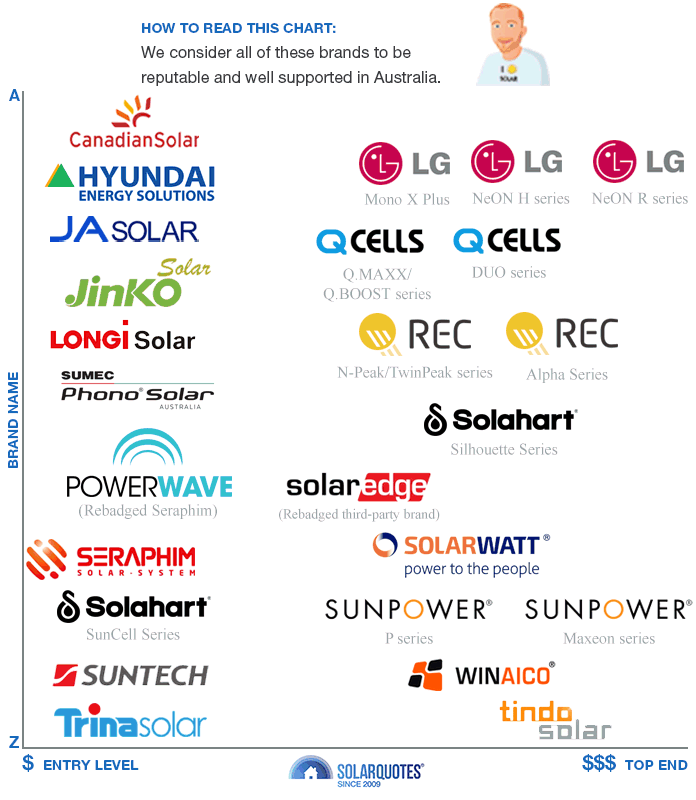

This chart has all the panels we’re confident are reliable and well-supported in Australia. If a manufacturer is not on the chart, it doesn’t necessarily mean their panels aren’t good. It may mean we don’t have enough information about them, or they may not have an Australian office. But they could be crap, so be careful. Do your research if you’re considering a solar panel we don’t recommend.
Warranties & Installation Manuals
It’s not enough to check warranties to see if panels can be installed flat. This is because warranties invariably contain a clause that says it will be rendered void if the instructions in the installation manual aren’t followed.
For panel manufacturers with multiple manuals, I checked the one for their panel most commonly installed on residential roofs. This means I didn’t check manuals for double glass panels apart from Solarwatt, who only make double glass panels.
I’ve described what I found for every solar panel brand on our recommended chart below. But if you don’t want to read through it all, the results are in a table at the end.
Canadian Solar
Canadian Solar doesn’t prohibit their panels from being installed flat but does state this in their installation manual:
“To maximize the annual yield, please calculate the optimum orientation and tilt for PV modules in that specific installation site.”
That’s doesn’t look like a requirement, but a polite request — as you’d expect from a Canadian2.
Hyundai
Hyundai Energy Solutions produce Hyundai solar panels. It has a market capitalization of around $300 million, so it’s not a small company. But some may not be aware it’s not technically part of the multi-billion dollar Hyundai Group, as they broke it into smaller, legally separate, companies a long time ago.
Like every warranty document, Hyundai Solar’s has a long list of conditions that will render it void. Just before listing them, the Hyundai warranty states this:


I underlined a few words in that statement that make me feel glad we have Consumer Guarantees in this country and make me feel glad we know how to spell the word “judgement” here. But, putting aside the spelling error, if a company claims it can decide entirely on its own whether a warranty has been rendered void or not, it’s obviously not a good warranty from the customer’s perspective.
Like every warranty, it says they can void it by not following the installation manual:


In the installation manual, it says don’t install them flat or horizontally, as it puts it:


JA Solar
JA Solar’s manual recommends installing panels at 10º or more:


But they phrase it as a recommendation and not a requirement.
Jinko Solar
Jinko recommends positioning solar panels to maximize their output, but neither the warranty nor installation manual prohibits flat installation.
LG Solar
LG Solar’s warranty says it doesn’t have vague, catch-all exclusions:


But rather than spell out all exclusions, like all other warranties, it requires you to look at the manual:


In their installation manual, they say panels can’t be laid flat:


If you wonder what efflorescence is, they’re using it to refer to a build-up of minerals. But I don’t think it technically counts as efflorescence. It seems more like an evaporite to me. But I only know one word of Korean, so I’m not exactly in a position to pick on their English.
In addition to not being laid flat, low angles must be avoided, although they don’t state how many degrees tilt is acceptable:


LONGi Solar
Longi doesn’t prohibit their panels from being laid flat. They merely make a suggestion…


It’s good to see Longi recognizes the importance of making it easy for ponding to flow away. I hate it when ponding hangs around after it has outstayed its welcome.
Phono Solar
Phono Solar does not prohibit panels from being laid flat but does recommend a minimum tilt of 10º…


Powerwave
Powerwave solar panels are rebadged Seraphim panels. This means that Seraphim makes them, and Powerwave puts their brand on them. Like Seraphim panels, they’re not restricted from being installed flat, but they do recommend at least a 10º tilt to “…to make the dust easily to be washed off.” This is the exact same bad English Seraphim uses in their installation manual.
Q CELLS
I couldn’t find a link to their warranty on the Australian Q CELLS site. This seems like a major site oversight to me. When I tried to go to the Q CELLS international site to look for it, I received a warning the site was potentially dangerous:


They should probably look into that.
The Australian site does have an installation manual that says they can’t be installed flat, but you can get pretty close. They require a minimum angle of 3º:
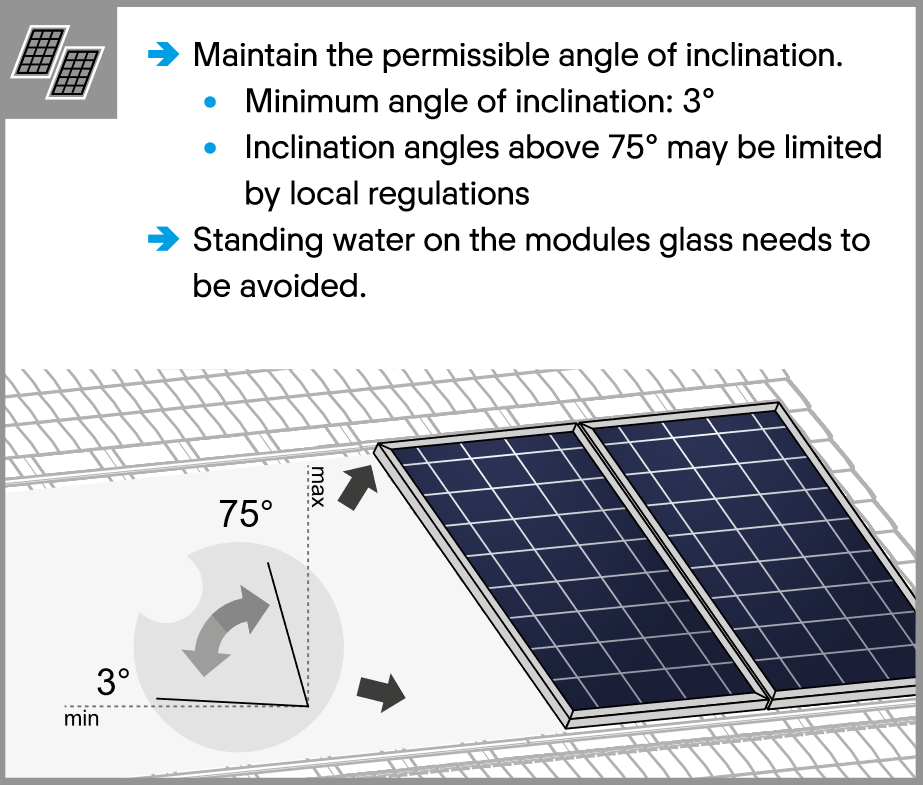

REC Solar — Good Panels, Lousy Website
I couldn’t find a link to a warranty document on the REC Solar site, so I used the site’s search function, and it provided me with a document from 2017. I couldn’t find an installation manual on the site either. What I did find was an installation manual using Google, which took me to the page on the REC site for downloading documents. When people have to leave your site and use Google to find stuff on that site, it’s not a good design.
If you’re using the REC site and actually want to read the warranty they spend hundreds of words boasting about, you’re out of luck unless you happen to know this stupid symbol means you can download stuff.




I didn’t use it because I had no idea what it was. To me, it looks like some kind of poo emoji. The bad website design is surprising because REC isn’t based in a country where they only got internet last week. REC panels are made in Singapore, where they’ve had the internet for at least several months.
The installation manual does not forbid installing REC solar panels flat but does say…
“Dependent on local conditions, a lower angle of installation will potentially increase the requirement for regular cleaning.”
It also specifically says the Ingress Protection (IP) rating of the panel’s junction box allows panels to be installed at any orientation:




Seraphim
Seraphim doesn’t forbid their panels from being laid flat. But they do recommend…




Solahart
Solahart currently uses Q CELLS panels, and, as mentioned above, they require a minimum tilt of 3º.
SolarEdge
Neither the SolarEdge warranty nor installation manual says these solar panels can’t be installed flat.
Solarwatt
Solarwatt doesn’t forbid their panels from being laid flat, but they do recommend a tilt of at least 15º.




SunPower
The SunPower installation manuals for both their Maxeon and Performance (P-Series) panels clearly states they can be mounted at any angle:




Suntech
Suntech does not say their panels cannot be mounted flat. The installation manual does say this…




Tindo Solar
Tindo Solar make their panels in Adelaide. They also make it very clear you must install their panels at 5º or more:




Trina Solar
Trina Solar does not forbid its panels from being laid flat.
Winaico
Two years ago, I wrote about how Winaico had solar panels with channels built into the corners to help water drain away from the surface if they’re installed at low or no tilt. But none of the panels they currently have on their Australian site has these channels. Their installation manual recommends a minimum tilt of 15º — possibly because of the lack of channels:




Summary
Here’s a table summarizing what I found:
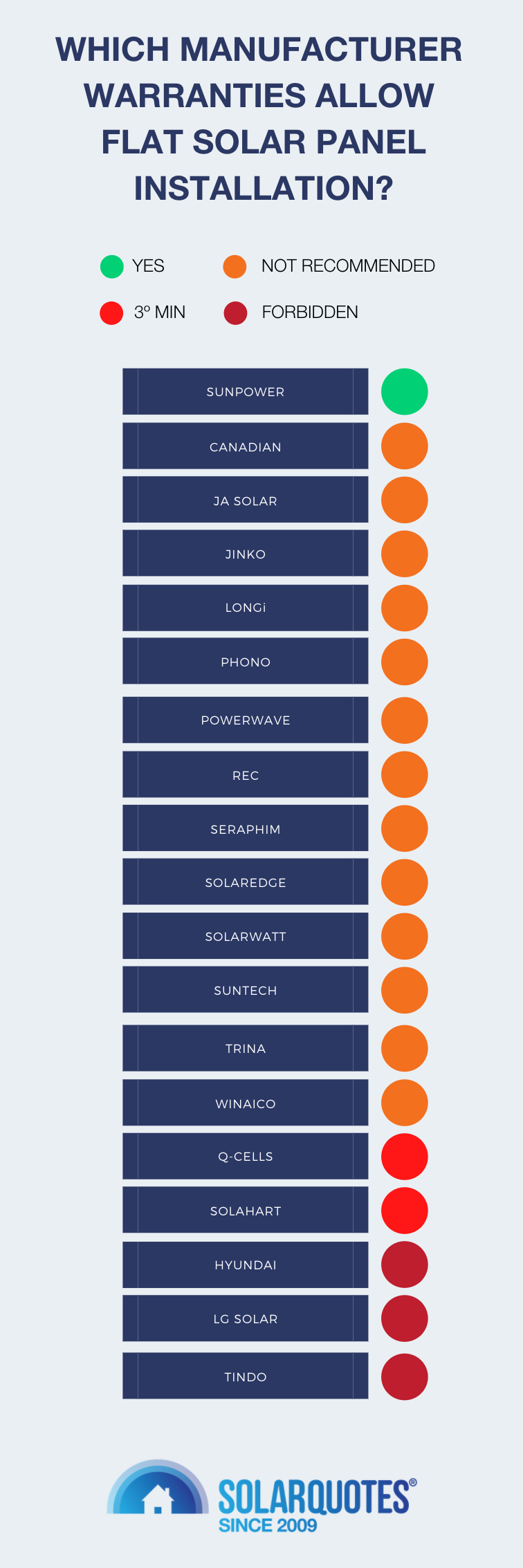



Out of the 19 brands I examined:
- Only SunPower said it’s okay to install their panels flat.
- 13 did not forbid flat solar panels, although they usually recommended installation at angles of at least 10-15 degrees.
- 2 brands — both manufactured by Q CELLS — require panels to have a tilt of at least 3 degrees.
- 3 brands rule out flat installation, but only one — Tindo Solar — gives a minimum required tilt.
Installation Options For Flat Roofs
If you really want to install solar panels flat, your options are:
- Use a SunPower panel and be confident there won’t be a problem with the warranty.
- Use a panel that doesn’t rule out flat installation.
- If your roof appears flat but has a tilt of 3 degrees or more, use panels made by Q CELLS panels. (This includes current Solahart panels). If the roof has a more visible slope of 5 degrees, Tindo Solar panels become an option.
If you are using a solar panel that doesn’t forbid flat installation and want to be confident the manufacturer won’t claim the warranty is void because they recommended installation at an angle, you can contact the manufacturer and see what they say.
But bear in mind that, thanks to Australian Consumer Law, the company that sold you the solar installation has to warrant the panels they install – no matter what silly things are written in the manufacturer’s warranty.
Footnotes
- Lightweight frameless panels that are instead glued on are already available from SunMan Energy and may soon be available from Maxeon. ↩
- While the company started in Canada and their headquarters are there, Canadian Solar doesn’t manufacture panels there. Also, if you look at their company map, they don’t seem to know where Canada is. But, like nearly all Canadians, they are against slavery. ↩
Original Source: https://www.solarquotes.com.au/blog/flat-solar-panels-warranty/

